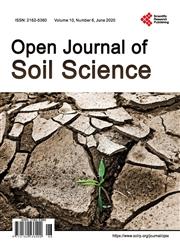Land Suitability Evaluation for Oil Palm (Elaeis guineensis Jacq.) in Coastal Plains of Southwest Cameroon
引用次数: 8
Abstract
Declining yields in oil palm fresh fruit bunch (FFB) have been recorded over the past years in the coastal lowlands of southwest Cameroon and current actual yields are very low (−1•yr−1) compared to the potential yields (25 t FFB ha−1•yr−1). One of the problems limiting optimum oil palm production is lack of detailed pedological information to guide plantation establishment and management. A land suitability evaluation was carried out for some major oil palm producing areas of southwest Cameroon to identify land qualities limiting optimal production. Thirteen sites (9 with sedimentary parent materials and 4 with volcanic parent material) were evaluated using a parametric method. Results indicate that climate was not a major limiting factor for oil palm production in coastal plains of southwest Cameroon. However, soil physical characteristics (mainly clayey texture and poor drainage) and soil fertility constitute limitations to oil palm production. Specifically, limitations in cation exchange capacity (CEC), base saturation (BS), organic carbon (OC) and pH were slight to moderate while K mole fraction was the most severe and the most limiting in all the sites. The fertility limitations were more pronounced in soils derived from sedimentary parent materials where 33% had limitations caused by soil pH and OC compared to none for volcanic soils. In addition, 77.8% of sedimentary soils had limitations caused by CEC compared to 25% for volcanic soils. Considering the overall suitability, soils derived from volcanic parent materials were potentially more suitable for oil palm cultivation ((S3)—50%, (S2)—50%) compared to sedimentary soils ((N)—11%, (S3)—78% and (S2)—11%). Based on the suitability classes of the different soils derived from dissimilar parent materials, appropriate site-specific soil management is needed to improve oil palm yields, especially with emphasis on K fertilization and improved soil water management. Plantation management in coastal plains of South West Cameroon therefore should factor in differences in soil parent material.喀麦隆西南部沿海平原油棕土地适宜性评价
过去几年,喀麦隆西南部沿海低地的油棕新鲜果束(FFB)产量有所下降,与潜在产量(25吨新鲜果束/公顷- 1•年- 1)相比,目前的实际产量非常低(- 1•年- 1)。制约油棕最佳产量的问题之一是缺乏详细的土壤学信息来指导种植园的建立和管理。对喀麦隆西南部一些主要油棕产区进行了土地适宜性评价,以确定限制最佳生产的土地质量。13个地点(9个为沉积母质,4个为火山母质)采用参数法进行评价。结果表明,气候不是喀麦隆西南部沿海平原油棕生产的主要限制因素。然而,土壤的物理特性(主要是粘土质地和排水不良)和土壤肥力构成了油棕生产的限制。其中,阳离子交换容量(CEC)、碱饱和度(BS)、有机碳(OC)和pH值的限制为轻度至中度,而K摩尔分数的限制最为严重。沉积母质土壤的肥力限制更为明显,其中33%的土壤受到土壤pH和OC的限制,而火山土则没有。此外,77.8%的沉积土存在CEC引起的限制,而火山土的这一比例为25%。考虑到总体适宜性,与沉积土壤((N) -11%, (S3) -78%和(S2) -11%)相比,火山母质土壤((S3) -50%, (S2) -50%)可能更适合油棕种植。根据不同母质产生的不同土壤的适宜性等级,需要适当的因地制宜的土壤管理来提高油棕产量,特别是强调钾肥和改善土壤水分管理。因此,喀麦隆西南部沿海平原的种植园管理应考虑到土壤母质的差异。
本文章由计算机程序翻译,如有差异,请以英文原文为准。
求助全文
约1分钟内获得全文
求助全文

 求助内容:
求助内容: 应助结果提醒方式:
应助结果提醒方式:


